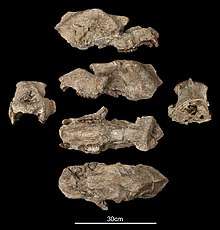Agriotherium
Agriotherium is an extinct genus of bears whose fossils are found in Miocene through Pleistocene-aged strata of North America, Europe, Africa, and Asia. This long-lived genus persisted from at least ~11.6–2.5 Mya.[2] Materials from the late-surviving A. africanum in Africa have suggested that A. africanum died out during the early Gelasian.[3]
| Agriotherium | |
|---|---|
 | |
| Views of skull | |
| Scientific classification | |
| Kingdom: | Animalia |
| Phylum: | Chordata |
| Class: | Mammalia |
| Order: | Carnivora |
| Family: | Ursidae |
| Subfamily: | †Agriotheriinae Kretzoi, 1929 |
| Genus: | †Agriotherium Wagner, 1837 |
| Type species | |
| †Agriotherium sivalensis Falconer & Cautley, 1836 | |
| Species[1] | |
|
†A. myanmarensis (Ogino et al., 2011) | |
Description and diet
Agriotherium was about 2.7 metres (9 ft) in body length and weighed around 900 kilograms (1,980 lb), making it larger than most living bears. Except for the extinct subspecies of the modern polar bear Ursus maritimus tyrannus and Arctotherium, Agriotherium and another short-faced bear, Arctodus simus, were the largest known members of terrestrial Carnivora. They had longer legs and shorter faces than other bears, and were more lightly built. Their wide, short jaws could generate enormous bite force. It is not certain how this force was used by the living animal; a study designed to determine how the genus fed discovered that among living bears, the lowest bite force belongs to the predatory polar bear, which feeds largely on blubber, and the highest bite force belongs to the giant panda, a herbivore which uses it to crush bamboo. Shortened jaws with high bite forces are found in other mammals like Gelada baboons that eat grasses but evolved from non-grazing ancestors, and in bone-crushing scavengers, like spotted hyenas and borphagine dogs.[4][5]
Analysis of the teeth, jaw, and tooth wear patterns identifies Agriotherium as an omnivore that ate a lot of plant material. Though its teeth do not show adaptations for a carnivorous diet, isotope evidence suggests it did eat a significant amount of animal material, similar to some populations of modern brown bears. Several studies of the skeleton, including a comparison with Hemicyon ursinus, a fossil bear widely accepted as a predator, show that Agriotherium did not have the limb strength or speed needed for active hunting, either by ambush or by chasing down prey. It also did not show the long claws and increased forelimb strength typical of mammals that dig for food. These very large bears may have specialized on a combination of grazing, eating fruit and invertebrate food in season, and intimidating predators away from carcasses in order to scavenge meat and bone marrow.[6]
Very large size would have been necessary to steal and defend kills in environments dominated by some of the most powerful carnivorous mammals that have ever lived, such as the sabertooth cat Amphimachairodus, with whom it shared territory in both China and North America, and the bone-cracking canid Epicyon and the massive feliform sabertooth Barbourofelis, which it lived alongside in Texas, as evidenced by fossil deposits at Coffee Ranch.[7][8]
Fossil distribution
Sites and age of specimens:
- American Cyanimid Company site, Bone Valley Formation, Polk County, Florida ~13.7—11.6 Ma.
- Venta del Moro, Spain ~9–5.3 Ma.
- Lang. E Quarry, South Africa ~5.3–3.6 Ma.
- Carlin High Quarry, Elko County, Nevada ~23–5.3 Ma.
- Vialette, Haute Loire, France ~3.2–2.5 Ma.
- Middle Awash, Ethiopia ~11.6–3.6 Ma.
Agriotherium ranged widely; fossils of four or more species have been found in Europe, Myanmar, China, North America and South Africa.[9] It is the only ursoid known to have colonized sub-Saharan Africa.[10]
References
- Ogino, Shintaro, Naoko Egi, and Masanaru Takai. "New species of Agriotherium (Mammalia, Carnivora) from the late Miocene to early Pliocene of central Myanmar." Journal of Asian Earth Sciences 42.3 (2011): 408-414.
- "Fossilworks: Agriotherium". fossilworks.org. Retrieved 2020-03-16.
- "Fossilworks: Agriotherium africanum". fossilworks.org. Retrieved 2020-03-16.
- Oldfield, C. C.; McHenry, C. R.; Clausen, P. D.; Chamoli, U.; Parr, W. C. H.; Stynder, D. D.; Wroe, S. (2012). "Finite element analysis of ursid cranial mechanics and the prediction of feeding behaviour in the extinct giant Agriotherium africanum". Journal of Zoology. 286 (2): 171–171. doi:10.1111/j.1469-7998.2011.00862.x. ISSN 1469-7998.
- Switek, Brian (2012-10-29). "Researchers Chew Over a Prehistoric Bear's Diet". Wired. ISSN 1059-1028. Retrieved 2020-03-16.
- Sorkin, B. (January 2006). "Ecomorphology of the giant short-faced bears Agriotherium and Arctodus". Historical Biology. 18 (1): 1–20. doi:10.1080/08912960500476366. ISSN 0891-2963.
- Antón, Mauricio (2013). Sabertooth. Bloomington, Indiana: University of Indiana Press. pp. 53–54. ISBN 9780253010421.
- Turner, Alan (1997). The Big Cats and their fossil relatives. New York: Columbia University Press. p. 201. ISBN 0-231-10228-3.
- Ogino, Shintaro; Egi, Naoko; Zin-Maung-Maung-Thein; Thaung-Htike; Takai, Masanaru (2011-08-10). "New species of Agriotherium (Mammalia, Carnivora) from the late Miocene to early Pliocene of central Myanmar". Journal of Asian Earth Sciences. Suture Zones and Geodynamic Processes. 42 (3): 408–414. doi:10.1016/j.jseaes.2011.05.017. ISSN 1367-9120.
- Howell, F. Clark; Garcia, Nuria (December 2007). "Carnivora (Mammalia) From Lemudong'o (Late Miocene: Narok District, Kenya)" (PDF). Kirtlandia. Cleveland Museum of Natural History. 556: 121–139. Retrieved 2009-10-15.
Sources
- Dalquest, W. W. (1986). "Lower Jaw and Dentition of the Hemphillian Bear, Agriotherium (Ursidae), with the Description of a New Species". Journal of Mammalogy. 67 (4): 623–631. doi:10.2307/1381124. JSTOR 1381124.
- Miller, W. E.; Carranza-Castañeda, O.; Carranza-Castaneda, Oscar (1996). "Agriotherium schneideri from the Hemphillian of Central Mexico". Journal of Mammalogy. 77 (2): 568–577. doi:10.2307/1382830. JSTOR 1382830.
- Petter, G.; Thomas, H. (1986). "Les Agriotheriinae (Mammalia, Carnivora)néogènes de l'Ancien Monde presence du genre Indarctos dans la faune de Menacer (ex−Marceau), Algérie". Geobios. 19: 573–586. doi:10.1016/s0016-6995(86)80055-9.
- Sorkin, B. (2006). "Ecomorphology of the giant short-faced bears Agriotherium and Arctodus". Historical Biology. 18: 1–20. doi:10.1080/08912960500476366.